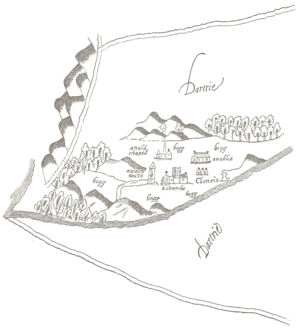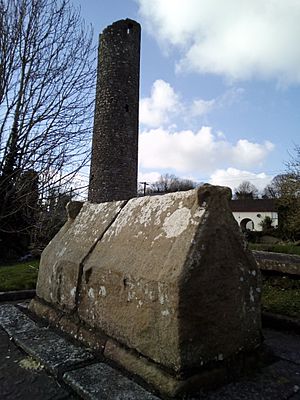Clones Abbey facts for kids
Quick facts for kids Clones Abbey |
|
|---|---|
| Native name Mainistir Cluain Eois | |
| Lua error in Module:Location_map at line 420: attempt to index field 'wikibase' (a nil value). | |
| Location | County Monaghan, Ireland |
| Area | Clones |
| Built | 12th century |
| Official name: Clones Abbey, Clones Church, Clones Round Tower | |
| Reference no. | 111 & 112 |
Clones Abbey is an old ruined monastery in County Monaghan, Ireland. It later became an Augustinian abbey in the 1100s. People sometimes called it "St. Tighernach Abbey" or the "wee abbey." This special place has many important religious sights.
A Look Back: History of Clones Abbey
The town of Clones and its abbey were started by a saint named St. Tighernach in the 500s. His abbey was dedicated to St. Peter and St. Paul.
Sadly, the abbey was damaged by fire several times, in 836, 1095, and 1184. In 1207, a powerful person named Hugh de Lacy destroyed both the abbey and the town. But just five years later, the English rebuilt them and even added a castle.
Today, you can still see parts of the 12th-century abbey on Abbey Street. There's a sarcophagus (a stone coffin) there, which people believe once held the remains of St. Tighernach. You can also see a tall, round tower from the 800s. It's about 22 meters (72 feet) high, but it used to be even taller with a pointy top!
Another amazing sight is a well-preserved high cross from the 900s. It's covered with detailed carvings of stories from the Bible. On one side, you can see scenes like Daniel in the lion's den or Abraham's sacrifice. On the other side, there are New Testament stories, such as Jesus feeding many people or the miracle at Cana.
In the 1500s, during a time called the Protestant Reformation, many monasteries like Clones Abbey were closed down. The monastic settlement in Clones was destroyed. By the 1600s, the abbey was mostly ruins. However, some monks continued to live in the area until the 1700s. Later, an English army group set up a camp within the ruins.
Building Style
The church at Clones Abbey was built in a style called Romanesque. This shows the influence of the Roman church in Clones. One interesting feature is a window with a rounded top, which was carved from a single stone. On the northern wall, there's also a small Celtic cross carved into a stone.
The Abbot of Clones
The leader of the abbey was called the abbot. The Abbot of Clones was very important. He was known as the Primus Abbas, which means the "first mitred abbot" of Ireland. A mitre is a special hat worn by important religious leaders.
Images for kids








